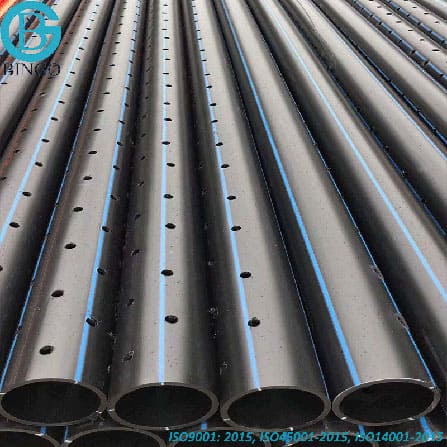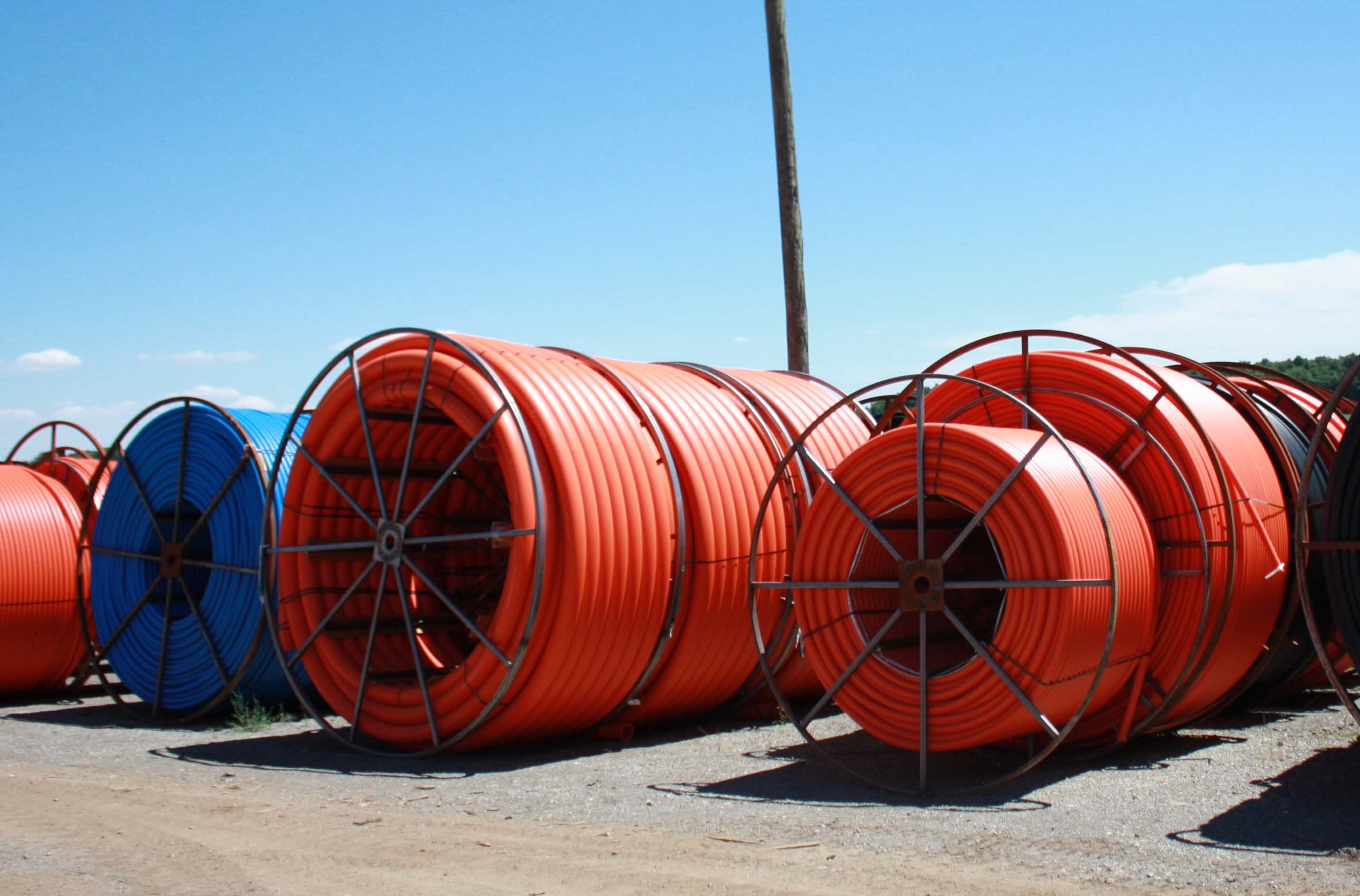Discover the Production Process Behind High-Quality HDPE Pipe and Its Applications
The production procedure of top quality HDPE pipelines is elaborate and methodical. It starts with the choice of basic materials that boost efficiency. Following this, ethylene goes through polymerization to form material, which is after that formed with extrusion. Quality assurance is paramount, guaranteeing that the end product satisfies rigid requirements. The journey of HDPE pipes does not finish with production. Their applications across numerous sectors expose a broader value worth taking a look at.
Recognizing HDPE: Characteristics and Advantages

High-density polyethylene (HDPE) is a functional thermoplastic known for its resilience and resistance to various ecological aspects. This product displays excellent tensile toughness, making it appropriate for requiring applications. Its low-density framework contributes to a lightweight item, assisting in simplicity of dealing with and installation. HDPE additionally showcases exceptional resistance to chemicals, which reduces degradation when revealed to rough materials.
The product's low wetness absorption additionally improves its durability, making it optimal for use in pipes and tank. Additionally, HDPE is immune to ultraviolet (UV) radiation, guaranteeing that items maintain their stability also when exposed to sunlight. Additionally, its flexibility permits the production of elaborate forms without endangering strength. The environment-friendly nature of HDPE, usually obtained from recycled products, includes to its allure, promoting sustainable practices in production. On the whole, these homes and advantages make HDPE a preferred selection for various commercial and consumer applications.
Basic Material Selection for HDPE Production
The selection of resources for HDPE production is crucial to confirm the final item fulfills the wanted requirements and top quality standards. High-density polyethylene (HDPE) is primarily produced from polymerized ethylene, derived from nonrenewable fuel sources such as natural gas or unrefined oil. The high quality of these feedstocks considerably influences the mechanical and thermal buildings of the last HDPE.
Additives also play a significant duty in boosting HDPE's efficiency, consisting of antioxidants, UV stabilizers, and colorants, which enhance longevity and resistance to environmental factors. The option procedure should consider not just the chemical structure of the raw materials yet additionally their processing features to ensure efficient production.
The sourcing of raw materials should focus on sustainability and compliance with ecological laws, as accountable practices are important in today's market. Inevitably, mindful basic material selection lays the structure for producing high-grade HDPE pipes ideal for diverse applications.
The Extrusion Refine: Shaping HDPE Pipeline
The extrusion process plays a crucial role in shaping HDPE pipelines, starting with precise product prep work techniques that ensure perfect circulation and uniformity. Equally crucial is the design of the die, which directly affects the last measurements and surface top quality of the pipe. Together, these factors add significantly to the effectiveness and top quality of HDPE pipe production.
Material Preparation Methods
Reliable manufacturing of HDPE pipelines starts with meticulous product prep work strategies, specifically the extrusion procedure. Throughout this phase, high-density polyethylene material is initial dried out to remove dampness, ensuring optimal circulation features. The material is after that fed right into the extruder, where it undergoes home heating and melting, changing right into a thick state. This home heating procedure is carefully controlled to maintain the material's honesty and performance. The molten HDPE is compelled through a die, forming it into a continual pipeline kind. Appropriate temperature level management throughout extrusion is necessary, as it directly affects the product's residential properties and the last product quality. Once shaped, the HDPE pipeline is cooled and cut to defined lengths, ready for succeeding processing and applications.
Die Design Importance
Accuracy in die style plays a necessary function in the extrusion process of HDPE pipelines. The die functions as the final shaping tool, straight influencing the pipe's measurements, wall surface density, and surface coating. A well-designed die guarantees consistent material circulation, minimizing problems such as abnormalities and weak areas. The geometry of the die should be maximized to suit the certain properties of HDPE, including its viscosity and thermal habits during extrusion. In addition, the cooling price of the material as it travels through the die can markedly influence the pipe's architectural honesty. As a result, purchasing sophisticated die technology is essential for suppliers intending to create high-grade HDPE pipelines that meet industry requirements and consumer expectations.
Quality Assurance Steps in HDPE Production
Numerous elements affect the high quality of HDPE pipeline production, effective high quality control actions are vital to guarantee uniformity and dependability in the final item (Pipe Supplier American Plastics Midland). Secret high quality control techniques consist of extensive product assessment, validating that the raw polyethylene satisfies well established criteria for pureness and density. Throughout the extrusion procedure, criteria such as temperature level, pressure, and cooling time are carefully checked to keep dimensional carbon steel fittings accuracy and structural stability
On top of that, post-production screening is important; suppliers usually carry out hydrostatic examinations to assess the pipeline's stamina and resistance to stress. Aesthetic inspections for surface area problems even more enhance top quality guarantee. Certification from appropriate standards organizations, like ASTM or ISO, gives an added layer of reputation. By applying these extensive quality assurance steps, suppliers can lessen defects, enhance performance, and ensure that the HDPE pipelines meet the particular requirements of numerous applications, inevitably causing consumer contentment and trust in the product.
Applications of HDPE Pipe Across Industries
HDPE pipelines are used throughout various fields as a result of their durability and convenience. In water circulation systems, they assure reliable distribution, while in wastewater monitoring, they give trustworthy services for waste transport. In addition, agricultural watering networks benefit from HDPE's resistance to corrosion and adaptability, making it a perfect selection for contemporary farming techniques.

Water Distribution Systems
A considerable number of sectors rely upon high-density polyethylene (HDPE) pipelines for effective water circulation systems. Recognized for their sturdiness and resistance to corrosion, HDPE pipes are widely used in local water networks, farming irrigation, and industrial applications. Their light-weight nature promotes easy handling and installment, decreasing labor expenses and time. Furthermore, HDPE pipes can suit various pressure degrees, making them ideal for both reduced and high-pressure systems. custom hdpe pipe manufacturing Midland TX. The flexibility of the material permits seamless combination into existing framework, lessening the demand for comprehensive excavation. Moreover, HDPE's resistance to chemical seeping guarantees that the water provided stays secure and clean, making it an ideal selection for preserving the quality of safe and clean water throughout numerous sectors
Wastewater Monitoring Solutions
Efficient water circulation systems also lead the way for innovative wastewater monitoring services, where high-density polyethylene (HDPE) pipes play a substantial role. Prominent for their resilience and resistance to deterioration, HDPE pipes are optimal for delivering wastewater in different settings. Their adaptability allows for simple setup in intricate environments, lessening the demand for considerable excavation. In addition, HDPE's smooth interior surface area reduces rubbing, boosting circulation rates and efficiency. These pipes are also resistant to chemical leaching, ensuring that contaminants do not endanger the surrounding atmosphere. Industries, communities, and treatment centers significantly rely upon HDPE pipes for their dependability and durability, making them a recommended selection for modern-day wastewater management systems. This flexibility highlights the crucial importance of HDPE pipes throughout various applications.
Agricultural Watering Networks
Agricultural irrigation networks benefit substantially from the usage of high-density polyethylene (HDPE) pipelines, which supply effective and trustworthy water shipment to plants. HDPE pipelines are light-weight, making them very easy to move and install, while their flexibility permits various setups in diverse terrains. These pipelines demonstrate superb resistance to corrosion, chemicals, and UV radiation, guaranteeing sturdiness in rough farming environments. Furthermore, their smooth interior surface minimizes rubbing loss, maximizing water flow and reducing energy prices connected with pumping. The durability of HDPE pipelines, typically going beyond 50 years, contributes to reduce maintenance and substitute expenditures. Farmers increasingly count on HDPE pipelines to enhance watering performance and promote lasting agricultural practices, eventually leading to enhanced crop yields and source conservation.
_-_Post_di_Facebook_-_Dimensioni_personalizzate_(1)_60cafdf20856f.png)
Future Patterns in HDPE Pipeline Modern Technology
As the need for lasting and reliable facilities grows, innovations in HDPE pipeline modern technology are positioned to change various industries. Emerging fads consist of the assimilation of clever innovations, such as sensing units and IoT abilities, which assist in real-time tracking of pipe problems, decreasing upkeep expenses and protecting against leakages. Furthermore, the growth of advanced manufacturing techniques, such as 3D printing, is allowing the manufacturing of complicated, customized pipe layouts that satisfy certain job requirements.
The emphasis on recycling and round economy techniques is driving the development of HDPE pipelines made from recycled products, enhancing sustainability. Improved jointing methods, such as electro-fusion and mechanical fittings, are additionally boosting installation performance and integrity. Finally, the growing emphasis on ecological guidelines is pressing manufacturers to take on greener production processes, making sure that HDPE pipelines not just fulfill industry criteria yet additionally foster a more sustainable future for infrastructure development.
Regularly Asked Inquiries
Exactly How Does HDPE Contrast to Various Other Plastic Materials?
HDPE outshines many various other plastic products relating to resilience, chemical resistance, and versatility. Its reduced density and high tensile toughness make it optimal for different applications, commonly surpassing choices in both performance and durability.
What Are the Ecological Effects of HDPE Manufacturing?
The environmental impacts of HDPE manufacturing consist of greenhouse gas emissions, power usage, and possible air pollution from making procedures. In addition, incorrect disposal can result in soil and water contamination, raising problems regarding lasting environmental impacts.
Can HDPE Pipes Be Recycled?
Yes, HDPE pipelines can be reused. Numerous facilities approve used HDPE for processing, changing it into brand-new items. This reusing adds to sustainability initiatives, minimizing plastic waste while preserving resources and energy in the manufacturing cycle.
What Is the Life-span of HDPE Pipes?

Exactly How Do Temperature Level Variations Impact HDPE Pipe Performance?
Temperature level variations greatly impact HDPE pipeline performance, influencing versatility and stamina. Heats can lead to softening, while low temperatures might cause brittleness, inevitably influencing the pipeline's toughness and suitability for different applications in varied atmospheres.